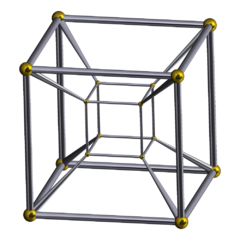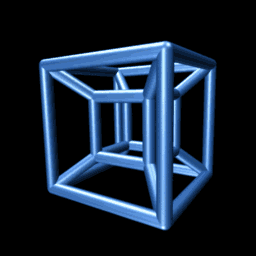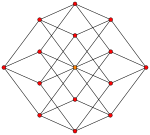Tesseract
From Wikipedia, the free encyclopedia
| Tesseract 8-cell 4-cube |
|
|---|---|
 Schlegel diagram |
|
| Type | Regular polychoron |
| Uniform index | 10 |
| Cell | 8 (4.4.4) |
| Faces | 24 {4} |
| Edges | 32 |
| Vertices | 16 |
| Vertex figure |  Tetrahedron |
| Schläfli symbol | {4,3,3} {4,3}x{} {4}x{4} {4}x{}x{} {}x{}x{}x{} |
| Coxeter-Dynkin diagram | |
| Petrie polygon | octagon |
| Coxeter group | C4, [3,3,4] |
| Dual | 16-cell |
| Properties | convex |

In geometry, the tesseract, also called an 8-cell or regular octachoron, is the four-dimensional analog of the cube. The tesseract is to the cube as the cube is to the square. Just as the surface of the cube consists of 6 square faces, the hypersurface of the tesseract consists of 8 cubical cells. The tesseract is one of the six convex regular 4-polytopes.
A generalization of the cube to dimensions greater than three is called a “hypercube”, “n-cube” or “measure polytope”. The tesseract is the four-dimensional hypercube, or 4-cube.
According to the Oxford English Dictionary, the word tesseract was coined and first used in 1888 by Charles Howard Hinton in his book A New Era of Thought, from the Greek “τέσσερεις ακτίνες” (“four rays”), referring to the four lines from each vertex to other vertices. Some people have called the same figure a “tetracube”, and also simply a "hypercube" (although a hypercube can be of any dimension).
Contents |
[edit] Geometry
The tesseract can be constructed in a number of different ways. As a regular polytope with three cubes folded together around every edge, it has Schläfli symbol {4,3,3}. Constructed as a 4D hyperprism made of two parallel cubes, it can be named as a composite Schläfli symbol {4,3}x{ }. As a duoprism, a Cartesian product of two squares, it can be named by a composite Schläfli symbol {4}x{4}.
Since each vertex of a tesseract is adjacent to four edges, the vertex figure of the tesseract is a regular tetrahedron. The dual polytope of the tesseract is called the hexadecachoron, or 16-cell, with Schläfli symbol {3,3,4}.
The standard tesseract in Euclidean 4-space is given as the convex hull of the points (±1, ±1, ±1, ±1). That is, it consists of the points:
A tesseract is bounded by eight hyperplanes (xi = ±1). Each pair of non-parallel hyperplanes intersects to form 24 square faces in a tesseract. Three cubes and three squares intersect at each edge. There are four cubes, six squares, and four edges meeting at every vertex. All in all, it consists of 8 cubes, 24 squares, 32 edges, and 16 vertices.
[edit] Projections to 2 dimensions
The construction of a hypercube can be imagined the following way:
- 1-dimensional: Two points A and B can be connected to a line, giving a new line AB.
- 2-dimensional: Two parallel lines AB and CD can be connected to become a square, with the corners marked as ABCD.
- 3-dimensional: Two parallel squares ABCD and EFGH can be connected to become a cube, with the corners marked as ABCDEFGH.
- 4-dimensional: Two parallel cubes ABCDEFGH and IJKLMNOP can be connected to become a hypercube, with the corners marked as ABCDEFGHIJKLMNOP.
This structure is not easily imagined but it is possible to project tesseracts into three- or two-dimensional spaces. Furthermore, projections on the 2D-plane become more instructive by rearranging the positions of the projected vertices. In this fashion, one can obtain pictures that no longer reflect the spatial relationships within the tesseract, but which illustrate the connection structure of the vertices, such as in the following examples:
A tesseract is in principle obtained by combining two cubes. The scheme is similar to the construction of a cube from two squares: juxtapose two copies of the lower dimensional cube and connect the corresponding vertices. Each edge of a tesseract is of the same length. A multitude of cubes that are nicely interconnected. The vertices of the tesseract with respect to the distance along the edges, with respect to the bottom point. This view is of interest when using tesseracts as the basis for a network topology to link multiple processors in parallel computing: the distance between two nodes is at most 4 and there are many different paths to allow weight balancing.
Tesseracts are also bipartite graphs, just as a path, square, cube and tree are.
[edit] Projections to 3 dimensions
The cell-first parallel projection of the tesseract into 3-dimensional space has a cubical envelope. The nearest and farthest cells are projected onto the cube, and the remaining 6 cells are projected onto the 6 square faces of the cube.
The face-first parallel projection of the tesseract into 3-dimensional space has a cuboidal envelope. Two pairs of cells project to the upper and lower halves of this envelope, and the 4 remaining cells project to the side faces.
The edge-first parallel projection of the tesseract into 3-dimensional space has an envelope in the shape of a hexagonal prism. Six cells project onto rhombic prisms, which are laid out in the hexagonal prism in a way analogous to how the faces of the 3D cube project onto 6 rhombs in a hexagonal envelope under vertex-first projection. The two remaining cells project onto the prism bases.
The vertex-first parallel projection of the tesseract into 3-dimensional space has a rhombic dodecahedral envelope. There are exactly two ways of decomposing a rhombic dodecahedron into 4 congruent parallelepipeds, giving a total of 8 possible parallelepipeds. The images of the tesseract's cells under this projection are precisely these 8 parallelepipeds. This projection is also the one with maximal volume.
[edit] Unfolding the tesseract
The tesseract can be unfolded into eight cubes, just as the cube can be unfolded into six squares (view animation). An unfolding of a polytope is called a net. There are 261 distinct nets of the tesseract.[1] The unfoldings of the tesseract can be counted by mapping the nets to paired trees (a tree together with a perfect matching in its complement).
[edit] Image gallery
| Perspective projections | ||||
 Stereographic projection (Edges are projected onto the 3-sphere) |
 Schlegel diagram Cell-centered |
 Schlegel diagram Vertex-centered |
 A 3D projection of an 8-cell performing a double rotation about two orthogonal planes. |
|
| Orthogonal projections | ||||
 |
 Projection inside Petrie polygon |
 |
 A net of a tesseract. |
|
 A stereoscopic 3D projection of a tesseract. |
Perspective with hidden volume elimination. See Fourth dimension. The red corner is the nearest in 4D and has 4 cubical cells meeting round it. |
|||
[edit] See also
- Fourth dimension
- Hypercube - The dimensional family of polytopes:
- Uniform polychoron#Tesseract family - uniform polychora based on tesseract
- Other regular polytopes
- Simplex - simplest polytope family
- Cross-polytope - The dual family to hypercubes
- Demihypercube - a family of alternated hypercubes
- List of regular polytopes
- 3-sphere
- Metatron's Cube
- Logical connectives
- Ludwig Schläfli - Polytopes
- Hasse diagram
[edit] References
- H. S. M. Coxeter, Regular Polytopes, 3rd. ed., Dover Publications, 1973. ISBN 0-486-61480-8.
[edit] External links
- Eric W. Weisstein, Tesseract at MathWorld.
- Olshevsky, George, Tesseract at Glossary for Hyperspace.
- Der 8-Zeller (8-cell) Marco Möller's Regular polytopes in R4 (German)
- WikiChoron: Tesseract
- HyperSolids is an open source program for the Apple Macintosh (Mac OS X and higher) which generates the five regular solids of three-dimensional space and the six regular hypersolids of four-dimensional space.
- Hypercube 98 via the Internet archive A Windows program that displays animated hypercubes, by Rudy Rucker
- ken perlin's home page A way to visualize hypercubes, by Ken Perlin
- Some Notes on the Fourth Dimension includes very good animated tutorials on several different aspects of the tesseract, by Davide P. Cervone
- Tesseract animation with hidden volume elimination
- A Study of Dimensions by Bill Price
|
||||||||||||||||||






